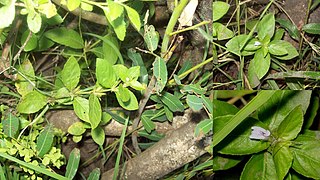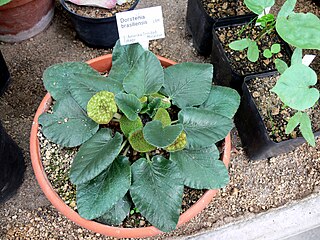
Carl Friedrich Philipp von Martius was a German botanist and explorer. Between 1817 and 1820, he travelled 10,000 km through Brazil while collecting botanical specimens. His most important work was a comprehensive flora of Brazil, Flora Brasiliensis, which he initiated in 1840 and was completed posthumously in 1906.

Stephan Friedrich Ladislaus Endlicher, also known as Endlicher István László, was an Austrian botanist, numismatist and Sinologist. He was a director of the Botanical Garden of Vienna.

August Wilhelm Eichler, also known under his Latinized name, Augustus Guilielmus Eichler, was a German botanist who developed a new system of classification of plants to reflect the concept of evolution. His author abbreviation in botany is Eichler.

Ruellia is a genus of flowering plants commonly known as ruellias or wild petunias. They are not closely related to petunias (Petunia) although both genera belong to the same euasterid clade. The genus was named in honor of Jean Ruelle (1474–1537), herbalist and physician to Francis I of France and translator of several works of Dioscorides.

Flora Brasiliensis is a book published between 1840 and 1906 by the editors Carl Friedrich Philipp von Martius, August Wilhelm Eichler, Ignatz Urban and many others. It contains taxonomic treatments of 22,767 species, mostly Brazilian angiosperms.

Verbena brasiliensis, the Brazilian verbena or Brazilian vervain, is a flowering plant species from the vervain family (Verbenaceae). It is native to parts of South America, namely Brazil, but has spread its range in recent times and has occasionally become an invasive weed. It is an annual plant with purple flowers, and it has been introduced outside of its native range as an ornamental plant, and is now largely considered an invasive weed in these regions.

Hygrophila costata, with the common names glush weed, gulf swampweed, and yerba de hicotea, is an aquatic plant.
Stenandrium pohlii, with Portuguese common names caiapiá or carapiá, is a species of flowering plant in the family Acanthaceae. It is a perennial native to Bolivia, Paraguay, and western, southeastern, and southern Brazil. It is native to Cerrado and Pantanal ecoregions of Brazil. The description of the plant was published in Flora Brasiliensis in 1847.

Stenandrium is a genus of flowering plants in the family Acanthaceae native to the Americas, with 50 species of perennial herbs ranging from the southern United States to northern Argentina and central Chile.

Jacaranda rufa is a medicinal plant native to Bolivia and Cerrado vegetation in Brazil. This plant is cited in Flora Brasiliensis by Carl Friedrich Philipp von Martius.

Asteranthos is a genus of woody plant in the family Lecythidaceae. There is only one known species, Asteranthos brasiliensis, native to Venezuela and Brazil.

Conospermum acerosum, commonly known as needle-leaved smokebush, is a species of flowering plant in family Proteaceae and is endemic to the south west of Western Australia. It is spindly, erect or straggly shrub with needle-shaped or thread-like leaves, panicles of white or pink flowers and reddish brown nuts.

Epilobium hirsutum is a flowering plant belonging to the willowherb genus Epilobium in the family Onagraceae. It is commonly known as the great willowherb, great hairy willowherb or hairy willowherb. Local names include codlins-and-cream, apple-pie and cherry-pie.

Dorstenia brasiliensis is a species of herbaceous plant in the family Moraceae of the order Rosales.

Lotus hirsutus, also known by the synonym Dorycnium hirsutum, common name: canary clover or hairy canary-clover, is a species of flowering plant in the legume family Fabaceae.
John Gillies was a Scottish naval surgeon who later became an explorer and botanist, travelling extensively in South America. Educated at the University of Edinburgh, he served in the Royal Navy during the Napoleonic Wars. Afflicted by tuberculosis, Gillies left the UK aged 28 for South America in the hope that the climate would improve his fragile health. He spent eight years there, mostly in Argentina, surviving wars, civil unrest, and chronic ill health, sending numerous plants to Hooker at the Royal Botanic Gardens Kew before returning in 1828. He died aged 42 at Edinburgh on 24 November 1834, his remains interred at Calton.

Hypericum hirsutum is a species of flowering plant in the family Hypericaceae, commonly known as hairy St John's-wort. It is found in Western Europe.
Adalbert Carl Friedrich Hellwig Conrad Schnizlein was a German botanist and pharmacist. He is largely remembered for his work in the fields of plant taxonomy and phytogeography.

Vaccinium hirsutum is a species of flowering plant in the heath family known by the common name hairy blueberry. This species is endemic to a small area in the southern Appalachian Mountains, where it is only known from a few counties in eastern Tennessee, northern Georgia, and the Carolinas.

Canarium hirsutum is a tree in the family Burseraceae. The specific epithet hirsutum comes from the Latin meaning "bristly", referring to the rough hairs of the fruit.















